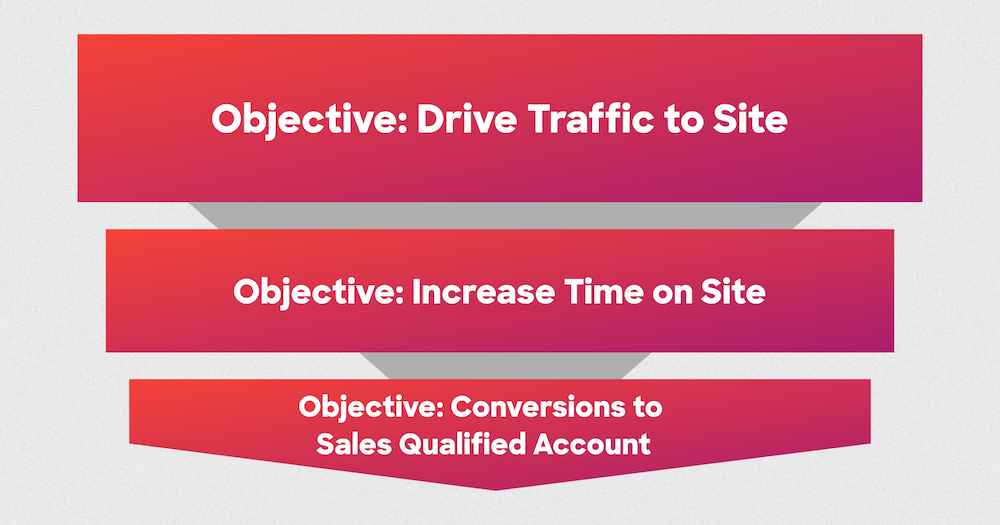In an era when personalization is key and relevance reigns supreme, audience segmentation is the cornerstone of an effective marketing strategy.
The days of a one-size-fits-all marketing strategy are long gone, replaced by a targeted approach that meets the needs of every business. It’s about quality, not quantity — and properly segmenting your audience allows for a balance in building brand awareness and nurturing the best-fit, high-engaged accounts.
What is Audience Segmentation?
Audience segmentation is the process of grouping prospects and customers together based on shared characteristics, such as industry, job title, or tech stack components. It helps create a more personalized approach to your marketing efforts because you can better understand the needs of similar accounts within your total addressable market.
Getting audience segmentation right requires a solid data foundation, clear goal-setting, and flexibility. No single strategy will work for every business, so it’s essential to take a phased approach to determine which segments generate the most upside for your business.
Here are the four crucial steps in any successful audience segmentation strategy.
Step 1: Invest in a Data Platform
The most important aspect of segmenting audiences is having strong, reliable data. The more thorough and complete your database is, the more precise your targeting.
For example: If you want to segment based on company size, such as small business or enterprise, then you need to have a database that can pull company financials, employee counts, and customer base. This level of detail helps curate a more accurate message to the best-fit accounts.
As your business grows and your customer base expands, access to quality data will increase the capacity to test out new filtering capabilities and refine your audience segments.
Step 2: Establish Your Goals
Create actionable goals that are relevant to the funnel stage you’re targeting. Having clear, differentiated goals for each audience ensures they are receiving the most relevant content and messaging depending on their stage in the funnel.

“Ask yourself what is the purpose of this list and what you’re looking to accomplish. That way you can map activities such as site visits or intent to drive engagement and move accounts through the funnel,” says Kaitlin Sanders, customer delivery manager at ZoomInfo.
It’s also important to clearly define how you will track conversions. We suggest segmenting based on the campaign objective: awareness, engagement, pipeline acceleration, and opportunity.
Here are some conversion stats we recommend tracking for each objective:
1. Defining conversion by awareness
Landing page views from target accounts
Target accounts that have visited your website
Accounts who visited your website for 10 seconds or more
Pageviews from target accounts that spent 10 seconds or more on your website
2. Defining conversion by engagement
Pageviews from target accounts on high-value pages (i.e. pricing page)
Target accounts that have engaged with high-value pages
Target accounts that have moved to another funnel stage
Target accounts and pageviews on campaign content
3. Defining conversion by pipeline acceleration
Target accounts that have become a sales qualified lead or marketing qualified lead
New opportunities created from target accounts
Content downloads and engagement from target accounts
Engaged qualified contacts from target accounts
4. Defining conversion by opportunity
Opportunities from target accounts that have closed/won
Annual recurring revenue generated from closed/won opportunities and the amount of ARR in the pipeline
Meetings booked by sales from target accounts
Percent decrease in time spent identifying contacts from qualified accounts
Percent increase in prospect response rate
Tracking metrics based on the objective will help you get a true sense of campaign performance over time.
Step 3: Choosing Audience Types
Segmenting based on ideal customer profile (ICP) characteristics will surface companies that align closely with your offerings, increasing the likelihood of successful lead generation and conversion.
Choose the right audience type to align with the goals established in the previous step. This will help you move beyond a one-size-fits-all approach.
There are four types of data points to help guide your audience segmentation efforts. Don’t think of these data points as standalone use cases — treat them as the components of a powerful audience segmentation strategy:
Here are some common use cases that our customers use to segment audiences at scale:
Website visitors
Categorize accounts based on their behavior on your website. This can include tracking which pages they visit, the duration of their visit, and the number of page views or unique visits. Take this audience to the next level by ranking high-priority pages, such as the pricing page or a demo request page. Website visitor identification software, such as WebSights, is a great way to automatically track activities.
Segmenting by website activity makes it easier to tailor follow-up communications and content to prospective accounts based on their demonstrated interests and engagement levels.
Pro tip: Set a parameter to only consider website visitors who stay on a page for more than 10 seconds. This will help filter out any additional noise in the results.
Intent data
Intent data is a great way to target accounts that are in the market for your product but haven’t made their way to your website yet. Creating an intent-based audience ensures that your team is covering all of its bases.
Some forms of intent data are more actionable than others. The ZoomInfo platform, for example, features Scoops — a combination of aggregated news updates pulled from public sources and proprietary insights gleaned from our continual surveys of industry professionals. Scoops can surface relevant data points like new investment rounds, changes in leadership, and even plans for the coming quarter or satisfaction with current vendors.
These events can give your marketing and sales teams a deeper level of insight into what’s top of mind at key accounts, allowing them to craft more relevant messaging and target decision-makers at the right time.
Competitive technology
Do you have a sense of which companies in your TAM are currently using a competitor’s product? Understanding the technologies your potential customers are using allows you to create targeted messages that emphasize how your solution offers unique benefits or integrates seamlessly with their existing setup.
You can build different audience segments based on each of your top competitors to really highlight competitive differences at scale.
Form tracking
It’s every marketer’s nightmare: a visitor lands on a high-intent webpage, starts filling out a form, and then leaves before it’s complete. Luckily, it’s possible to track abandoned forms and create an audience for accounts that showed interest but didn’t convert. You can then implement retargeting strategies, like sending reminder emails or providing additional incentives, to encourage them to complete the form and engage further.
On the flip side, if a company does complete the form on your website, you can also create a segment to automatically target those accounts with more relevant content that keeps them engaged.
Audience retargeting
If potential customers engage with your business multiple times without converting, building a segment to retarget those audiences can help push them further down the funnel. Launching targeted display ads to different segments based on the context in which they have engaged with your brand is a great way to scale those efforts.
Combined audiences
The next level of audience segmentation is building combined audiences. This involves combining multiple segmentation criteria to create more refined audience segments. For example, you might combine firmographic data points with behavioral data to create segments that align with specific industries and show a high level of interest in your content.
Step 4: Scale and Refine Over Time
Creating an audience segmentation strategy is a process that should scale over time. We recommend taking a crawl, walk, run approach to determine which segments are most successful.
Crawl
When you’re first starting out, create a simple audience to drive brand awareness.
“I encourage new customers to target in-market accounts based on their intent,” Sanders says. “Select intent topics that align with campaign content. Add in some parameters, such as intent score or audience strength, and layer demographic and firmographic data points to surface an initial list of interested accounts.”
This exercise will narrow down your total addressable market to focus on those that are actively showing interest. From there, you can start scaling your strategy by adding in some more advanced filters, or data points, to create multiple audiences.
Walk
The walk phase involves incorporating new data points, adjusting existing segments, and identifying emerging segments that were not initially considered.
Test out more advanced filters such as technologies, scoops, and business attributes, and analyze data to better understand which segments are successful. Some segments might prove more valuable than others, and your strategy should adapt accordingly.
Run
By the time you enter the run phase, you have a strong grasp on your core audiences, which are well-integrated into your overall go-to-market strategy. The focus in this phase is on optimization and continuous improvement.
You might decide to test out more advanced audience segmentation strategies, such as ZoomInfo’s dynamic Audiences. These audience segments can adapt in real-time based on customer interactions and changes in behavior, making it possible for you to adapt based on changing customer needs. Regular refinement helps you allocate resources more efficiently, deliver more precise messaging, and build stronger connections with your audience.
Get Started Today
B2B audience segmentation relies on accurate data and ongoing refinement. By tailoring your marketing efforts to address the unique needs and characteristics of different B2B audience segments, you can build stronger relationships and generate more impactful results.
If you want to find the right leads, build and manage campaigns, and reach your target audience all from one platform, try ZoomInfo Marketing today.


